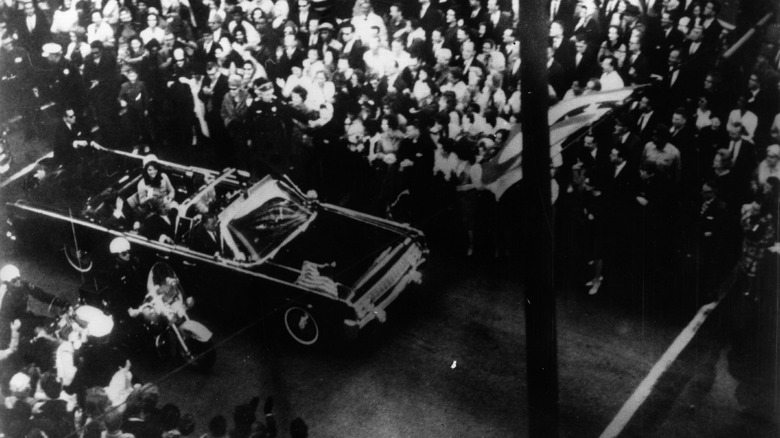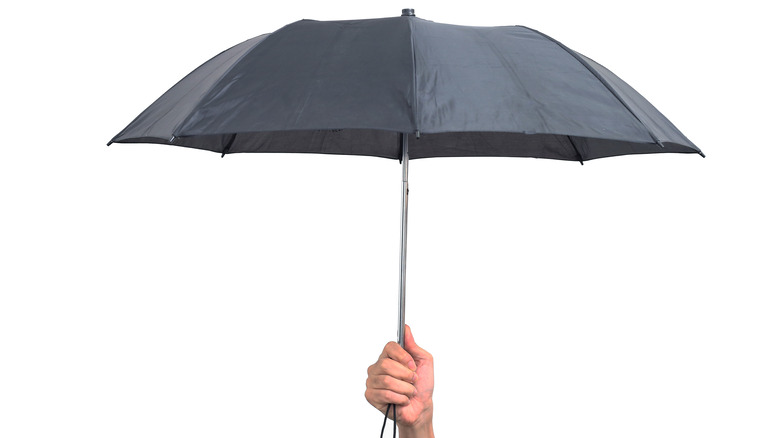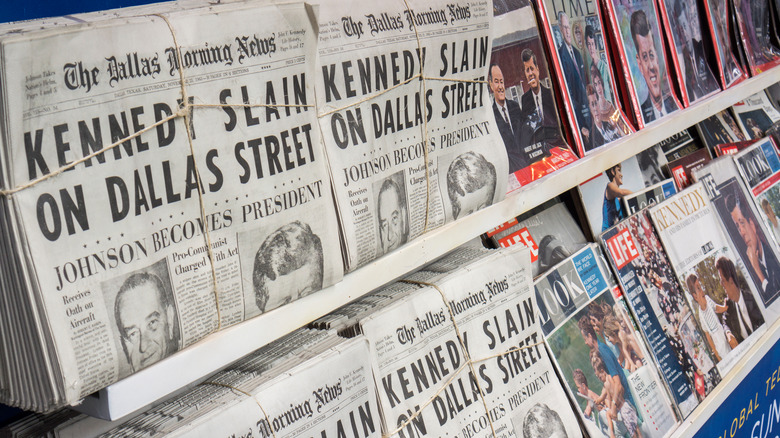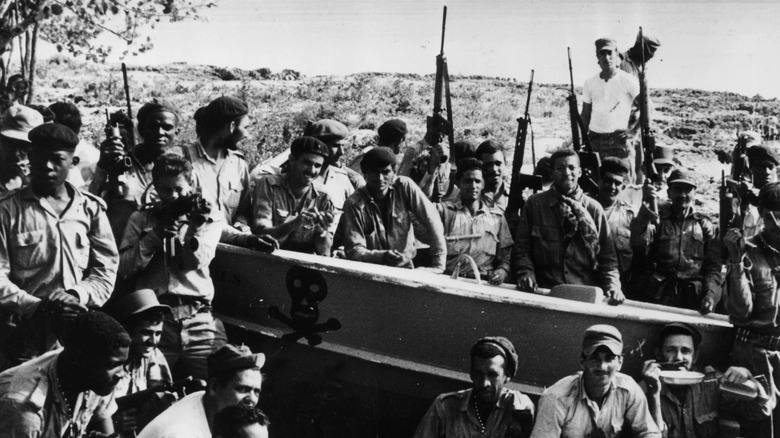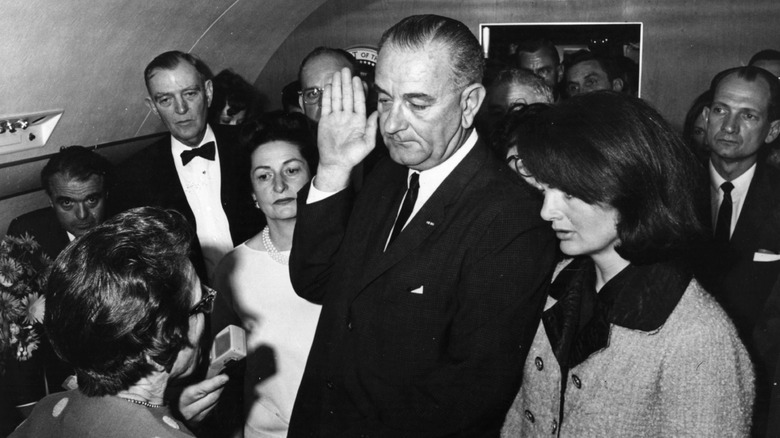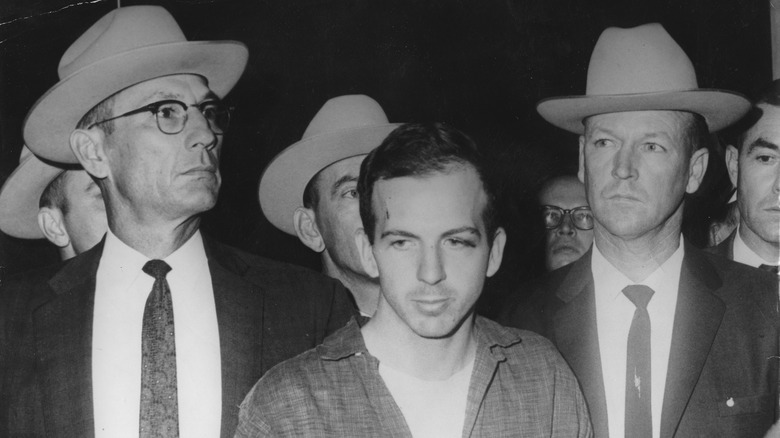The Biggest Theories About JFK's Assassination
On November 22, 1963, President John F. Kennedy was shot and killed while riding in an open-top car as part of a motorcade traveling through Dallas, Texas. The circumstances of the assassination were initially blurry, though the subsequent Warren Commission assessed evidence including notorious amateur footage that came to be know as the Zapruder film to conclude that the president had been killed by Lee Harvey Oswald, who, acting alone, had fired from the window the Texas Book Depository.
Today, most people are familiar with the details of JFK's assassination, an event as shocking to the American psyche as the attack on Pearl Harbor. But though the details are common knowledge, the public remains suspicious about the official version of events. According to a 2013 survey carried out on the 50th anniversary of the momentous murder, more than half of Americans — 61% — continue to doubt the Warren Commission's findings: that a single man was responsible for the murder (per Gallup).
According to CNN, the author Vincent Bugliosi has undertaken a survey of all those theories that run against the official story of who was behind Kennedy's assassination, and has concluded that conspiracy theorists "have accused 42 groups, 82 assassins and 214 people of being involved in the assassination." Here are a few of those who have been accused, and why.
The umbrella man
Following the assassination, conspiracy believers focused on one piece of evidence more than any other: the Zapruder film, a home movie shot on super-8 film which clearly showed Kennedy's motorcade and those closest to the car at the time of the attack. One figure they zero in on was the "umbrella man," an unidentified man spotted on the sidewalk near the president at the time of the shooting, who, conspicuously, was holding aloft an umbrella on an otherwise sunny day.
In 2011, The New York Times spoke to author Josiah Thomson ("Six Seconds in Dallas") about theories concerning the umbrella man (via YouTube). Thomson explained that early investigators believed that the umbrella could have been used as a signal for multiple shooters in a coordinated attack planned by the CIA, with one arguing that the umbrella itself could have been fitted with a device that fired one of the shots.
The umbrella man eventually revealed himself as Louie Steven Witt, per Town and Country. In 1976, Witt revealed himself before the House Assassinations Committee. Witt explained that his use of an umbrella on an otherwise clear day was intended as an innocent — albeit obscure — form of protest. Apparently, the item was a reference to Neville Chamberlain, the wartime British Prime Minister who had unsuccessfully adopted a policy of appeasement against Adolf Hitler. Kennedy's father, Joseph, had been a Chamberlain supporter, and per History Matters, Witt, a conservative, claimed that a friend had told him that umbrellas represented a "sore spot" for the Kennedys, and had gone with the intention of heckling the Democratic president.
JFK was killed by the mafia
One enduring theory concerning the assassination of President Kennedy stipulates that rather than being the victim of an unhinged man acting alone, he was in fact the target of a mob hit. According to Biography, one theory suggests that the mafia was enraged by the Kennedy family's political efforts to end the crime family's stranglehold on the Teamsters Labor Union. The Teamsters had been led since 1957 by Jimmy Hoffa, whose connections to the mob were well known. John Kennedy's brother Robert, as attorney general, had filed criminal charges against Hoffa as a racketeer, ultimately leading to Hoffa's imprisonment. Proponents of this theory believe that the mafia had a second shooter at the location who may have fired the fatal shot.
The presence of a second shooter was first suggested by the House Select Committee on Assassinations, who released evidence in 1975 that a police microphone had picked up the sound of a fourth shot — previous reports had always claimed Oswald had fired three rounds — which had not come from Oswald's gun, per Britannica.
The Cuban connection
Conspiracy theorists point to further political developments that might have motivated the mafia to kill President John F. Kennedy, such as his mishandled conflict with Cuba, according to History. It has been suggested that Kennedy's failed Bay of Pigs invasion meant that Cuba would remain in the hands of the communist revolutionary Fidel Castro, cutting off the mob's former revenue streams from the island. They organized the killing of Kennedy as revenge for their losses.
But as noted by The Conversation, a number of theorists have claimed that the president was in fact killed on behalf of Cuba itself, offering the fact that Lee Harvey Oswald had previously declared himself a Marxist to suggest that the shooter was sympathetic to the communist revolution and had murdered the president in direct support of Castro. Some suggested that the killer may even have had contact with Cuban agents in Mexico, and that he had planned to flee to either Mexico or Cuba after the assassination.
LBJ had JFK killed
One rather insidious theory argues that John F. Kennedy wasn't killed by outside agents at all, but in fact was the target of a hit organized by one of his closest political allies: his vice president, Lyndon B. Johnson, who had his fellow Democrat killed to consolidate power in his own hands. It was Johnson who took over the presidency just two hours after Kennedy's death, and who set up the Warren Report which found that Lee Harvey Oswald had acted alone, per History.
This rather outrageous theory became mainstream back in 2013 thanks to the book "The Man Who Killed Kennedy: the Case Against LBJ," which featured a mugshot of President Johnson on the cover and became a New York Times Bestseller. The author? Roger Stone, the now-disgraced political fixer who helped Donald Trump to enter the White House, and who has since been subpoenaed for his involvement in the Capitol Hill Riots of January, 6, 2021, according to Independent.
To compose his thesis, Stone "gathered documents and uses his firsthand knowledge to construct the ultimate tome to prove that LBJ was not only involved in JFK's assassination, but was in fact the mastermind," according to his publisher, Simon & Schuster. However, despite the popularity of the book, which was conspicuously timed for publication with the 50th anniversary of the assassination, no further criminal investigations have been opened as a result.
Oswald actually acted alone
But despite the efforts of numerous investigators, authors, and armchair conspiracy theorists of all stripes, the theory that Lee Harvey Oswald acted alone with little coherent motivation remains the official story as far as the law is concerned. In 1979, the House Select Committee on Assassinations concluded that there may have been a second shooter involved in the killing, and that therefore President John F. Kennedy was the victim of a conspiracy. However, the findings of the committee have since been refuted, with the report's "scientific acoustic evidence" for the presence of a second shooter having since been discredited by the National Academy of Sciences, which in 1982 concluded that "reliable acoustic data do not support a conclusion that there was a second gunman," per ABC News.
Experts now believe that though Oswald was involved in radical politics, his actions stemmed from the same need as that which motivated the killing: his insatiable need to inflate his own ego, per History News Network.
Although the assassination still attracts a great deal of attention, the 2013 survey claiming 61% of citizens suspect a conspiracy is, in fact, the lowest total since the incident itself, according to Gallup. As time goes by, more and more of us are beginning to lose our skepticism, and to come to the conclusion that the world really is unpredictable and chaotic enough for a lone, unhinged killer to murder the world's most powerful man for no understandable reason.
